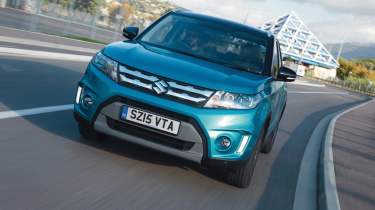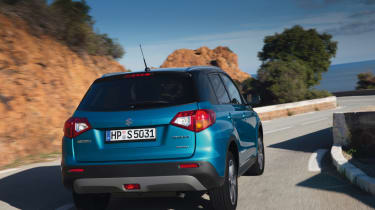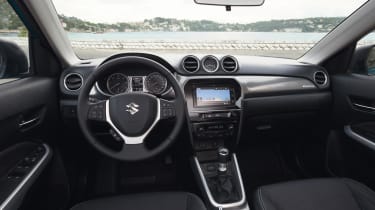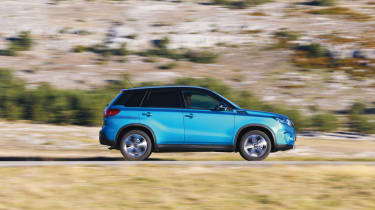Suzuki Vitara review, prices, specs and rivals
The Vitara softens up as a mid-size crossover
What is it?
This is the new Suzuki Vitara. As the fourth generation of Suzuki’s long standing ‘soft-roader’, the new Vitara blurs the lines between a proper off-road vehicle and urban crossover.
For starters, it is available with either four- or two-wheel drive, with the latter drivetrain utilising Suzuki’s electrically operated AllGrip system. This, along with the car’s more stylish exterior, suggests the new Vitara is less rugged than its predecessors.
But with a class leading 185mm of ground clearance and two efficient drivetrains, the Vitara could be just as useful on rough-terrain as it is in city back streets. We head off to Cheddar Gorge to find out.
Engine, transmission and 0-62mph time
The Vitara is available with two engines. The first is a 1.6-litre four-cylinder petrol, capable of producing 118bhp at 6000rpm and 115lb ft of torque at 4400rpm. The second is a 1.6-litre four-cylinder turbo diesel, which produces 118bhp at 3750rpm and 236lb ft of torque at 1750rpm.
The diesel offers the stronger performance; although 0-62mph times are the same for both engines at a claimed 11.5sec, however, the diesel’s fuel economy is almost 25 per cent better, achieving a claimed 70.6mpg combined, compared to 53.3mpg.
The petrol comes available with a five-speed manual gearbox, with a six-speed automatic due later in the summer. The diesel exclusively receives a six-speed manual gearbox. Both engines send power to the front wheels on SZ4 and SZT models, with AllGrip four-wheel drive available as an option on the top of the range SZ5.
More reviews
Group tests
- Alpine A290 v Alpine A110 – how much DNA do they really share?
- Ariel Atom 4R v Caterham Seven ‘evo25’: power-to-weight heroes go head-to-head
- Caterham Super Seven 600 v Super Seven 2000
- Levante v T1
- Corvette Stingray v Porsche Cayman GTS v Audi R8 RWD
- Great Ferrari hypercars driven: 288 GTO, F40, F50 and Enzo head-to-head
- Hardcore Ferrari V8 specials go head-to-head
- Lamborghini Aventador Ultimae v Lamborghini Countach
- Lotus Emira v Morgan Plus Four – four-cylinder Brits go head-to-head
- Toyota GR86 v BBR Mazda MX-5: supercharged drop-top battles sports coupe
In-depth reviews
- Abarth 600e 2025 review – Italy gives the Alpine A290 something to worry about
- Alpine A110 review – distinctive, lightweight and unforgettable to drive
- Audi R8 (2015 - 2024) review – the ultimate soft-focus supercar
- Bentley Continental R Mulliner: review, history and specs
- BMW 5-series review – is this still Munich’s anchor model?
- BMW 1-series review – Munich’s Audi A3 rival gains focus
Long term tests
- Abarth 695C Turismo Fast Fleet test – 10,000 miles in the Italian hot hatch
- Alfa Romeo Giulia Veloce Fast Fleet test – 7000 miles in the sharp Italian saloon
- Alpina B10: end of term report
- Alpina B10
- Ford Mustang GT
- Ford Mustang GT
- Ford Mustang GT
- Land Rover Defender 110 Fast Fleet test – 9000 miles in the go-anywhere SUV
- Maserati Ghibli Trofeo Fast Fleet test – 4000 miles in the Ferrari-powered saloon
- Mitsubishi Evo MR 340
Review
- New Aston Martin DBS 770 Ultimate review – 759bhp super-GT driven
- New Bentley Batur 2023 review – can it possibly be worth £1.65m?
- 2023 Chevrolet Corvette C8 Z06 review – the American 911 GT3?
- Kia EV6 GT-Line S prototype review – the EV that shows how it’s done
- BBR Supercharged Mazda MX-5 (ND) 2023 review – tuned 250bhp roadster driven
- MG4 Trophy 2023 review
Reviews
- Abarth 695 75 Anniversario edition 2024 review – a fitting send-off for Abarth’s hot supermini?
- Abarth 500e 2023 review
- AC Cobra 378 Superblower MkIV 2021 review – another V8 Cobra, but with a GM heart this time
- Acura Integra Type S 2024 review – a Honda Civic Type R with added restraint
- Alfa Romeo Giulia 2025 review – get one while you still can
- Alfa Romeo SZ: history, review and specs of an icon
- Alfa Romeo 1750 TBi
- Alpina B3 GT Touring 2025 review – a 190mph alternative to the BMW M3 Touring
Bragging rights come thanks to the Vitara’s low CO2 outputs, with the petrol achieving 123g/km and the more efficient diesel achieving as little as 106g/km in two-wheel drive cars. This makes the Vitara the second most efficient non-hybrid SUV on sale in the UK; its sibling, the Swift 4x4, ranks top.
Technical highlights
Suzuki hopes the Vitara’s standard equipment will tempt buyers away from its main rivals. Included on all models is auto stop/start, cruise control with a speed limiter, hill hold control, brake assist, climate control, heated door mirrors and a DAB digital radio with Bluetooth integration.
Optional satnav comes as part of a touchscreen infotainment display, while another popular option will likely be a two-part panoramic sunroof (it comes as standard on the SZ5).
With a 60:40 folding rear bench also standard, the Vitara can swallow 375 litres of luggage with the seats up, beating a key rival, the Nissan Juke, by 23 litres. Fold them down though, and the Vitara’s 710 litres of available space is some way off the Juke’s 1189 litres of space.
What’s it like to drive?
The Vitara might be marketed as a proper SUV, but slipping into our SZ5’s suede and leather seats, it feels just like a conventional crossover: tall, but very car-like.
The story is much the same once moving, because the Vitara rides like a normal hatchback, responding to swift steering inputs with minimal body roll. It’s well damped and as such feels comfortable being tilted into corners with the sort of exuberance something this tall shouldn’t tolerate.
Admittedly, the electric steering doesn’t provide any feel in Normal or Sport modes, but the latter setting does at least quicken the engine’s response to throttle inputs. The diesel feels particularly eager in this mode, pulling strongly through the mid-range. Rev it out, and the unit turns gruff and breathless, but work around 2500rpm and it feels faster than its 0-62mph time suggests.
Unsurprisingly, the petrol engine offers its best performance if you hang onto each gear a little longer, though it still never quite matches the acceleration of its turbocharged rivals.
The Vitara’s manual gearbox features a nicely weighted lever - partly thanks to Suzuki’s use of a counter weight – making smooth, fast up-changes easy. Fast down-changes can feel a little notchy, though we suspect this will improve with higher mileage.
Venture off-road in an AllGrip equipped Vitara, and its hatchback-like ride initially feels a little too firm, as the body shakes its way over rocky surfaces. But drive the car down a steep decline or accelerate hard up an incline, and that planted stance helps keep the car’s centre of gravity low.
The AllGrip four-wheel drive is simple to use (it’s switch activated), and can automatically shift torque between the axles to minimise wheelspin and maximise drive. Switch AllGrip into Snow/Mud mode, and traction issues are sorted out automatically, while standard fit hill hold control and hill descent control (only available on SZ5 AllGrip models) make climbing and descending much simpler.
Don’t be fooled though, this is no out-and-out off-roader. A distinct lack of underbody protection (illustrated most clearly by a low hanging exhaust box) and the fitment of road tyres confirm the really rough stuff is out of reach. For that, Suzuki makes the Jimny.
Rivals
Though the Vitara is part of a segment dominated by the Nissan Juke, the Skoda Yeti stands out as a more directly comparable rival. At first, things don’t look great, because the Yeti is equally as impressive off-road, and comes available with more potent engines.
The Suzuki’s use of scratchy, hard-touch plastics on the dash also make the Yeti feel more premium inside, but the Skoda’s £16,915 starting price is close to £1000 more expensive.
Another strong selling rival is the Fiat 500X. The 500X’s four-wheel drive system is shared with the Jeep Renegade, and as such it is impressive given its size. It also undercuts the Vitara with a £14,595 starting price, but high running costs and the 500X’s bulbous looks could quite easily send buyers elsewhere.
Price
Two-wheel drive petrol Vitaras start at £15,929, but AllGrip SZ5s require £20,599. Opt for a diesel SZ5 AllGrip, and you’ll need to spend an additional £1400, meaning the Suzuki is entering waters patrolled by far larger SUVs (including the Nissan Qashqai).
It’s the Suzuki’s on-road handling, nicely weighted controls and cheap running costs that will help justify its price tag. And with target sales of just 6000 units per annum, it’ll also be one of the most exclusive options in the class.








